The Role of Texture Contrast in Eye-Catching Outfits
페이지 정보

본문

Texture contrast plays a powerful but often overlooked role in creating visually arresting looks. While color and pattern grab immediate attention, it is the tactile juxtaposition that adds richness, structure, and intrigue to an ensemble. Think of the way a chunky knit sweater looks against glossy faux leather trousers or how a silky blouse contrasts with a textured tweed midi. These combinations don’t just look good—they convey deliberate artistry.
Our eyes are inherently attracted to tactile transitions. A plush merino wrap draped over a crisp herringbone overcoat creates a tactile dialogue that makes the outfit feel more nuanced and intentional. Even in clean, pared-down outfits, texture contrast can elevate a look from ordinary to extraordinary. A plain cotton tee and denim tears shorts become more memorable when the jeans are unwashed indigo selvedge and the t-shirt is made from a textured organic cotton-linen.
Texture contrast also helps modulate volume and shape. A extravagant bishop cuff in a crisp taffeta can be grounded by gliding silk leggings. The contrast subdues the exaggeration while adding a finishing touch of opulence. Conversely, a softly cascading skirt can be anchored by a precision-cut coat in boucle wool, making the look feel more grounded and polished.
Beyond aesthetics, texture contrast adds a sensory element to fashion. When people see something with diverse surface treatments, they often imagine how it would feel to touch it. This hidden sensory connection makes the outfit more memorable and intriguing. It’s why a look featuring a dull-finish handbag beside a mirror-like vegan leather heel tends to stay etched in memory than one made of monotonous surfaces.
Designers use texture contrast deliberately because it resonates. Whether it’s pairing shearling with brass zippers, delicate embroidery with rugged jeans, or cable-knit with charmeuse, the magic happens in the tension between opposites. Even in relaxed looks, swapping out a cotton hoodie for one with a raised jacquard weave can make a profound stylistic shift.
The key is to be mindful of the balance. Too many overloaded materials can look messy, while too little can feel flat. Start by choosing one dominant texture and introduce one or two complementary surfaces to support it. Let the textures enhance rather than compete. Pay attention to the size of the texture—a smooth silk next to rough corduroy creates more contrast than two similarly fine materials.
Ultimately, texture contrast is about infusing personality into clothing. It transforms clothing from something worn to something experienced. In a world where fashion is often reduced to trends and hashtags, texture reminds us that clothing is grounded in touch and presence. Mastering it doesn’t require a expensive pieces or expert tailoring—it just requires seeing beyond the surface and embracing contrast. That’s where personal expression is born.
- 이전글How to Ethically Recycle Used Clothes 25.10.24
- 다음글Demo Wu Xia Playstar Rupiah 25.10.24
댓글목록
등록된 댓글이 없습니다.
